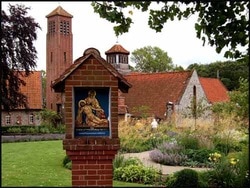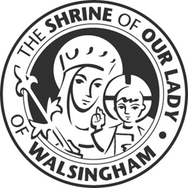Walsingham
 Welsh pilgrims statue of Dewi Sant at the Shrine - given by the pilgrims from Wales.
Welsh pilgrims statue of Dewi Sant at the Shrine - given by the pilgrims from Wales.
The Anglican Shrine occupies an island site in the village of Little Walsingham, five miles from the north Norfolk coast. Close to the ruins of the original medieval Priory (destroyed in 1538), the present-day Shrine was gradually created from 1931 from derelict farm buildings and cottages with a brand new Shrine Church in the south-east corner of the site.
Within the Shrine Church is the "Holy House" a 'recreation' of the house in Nazareth where Mary received the news from the angel Gabriel that she was to be the mother of Our Lord, Jesus. Within the Holy House, above the altar, is the niche where the statue of Our Lady of Walsingham sits surrounded by candles and votive lights.
The statue of Our Lady of Walsingham is much-loved. It is important to understand that the statue is simply a focus for devotion - a visual aid - and not something to be worshipped in itself. Down through the years Christians have sought the prayers of Mary to support them in their pilgrimage through life. At times in the history of the church there has been controversy about devotion to Mary but in these ecumenical days there are few who would deny a right respect and love to the Mother of Jesus.
Pilgrims have made the journey to Walsingham from all over Britain - and the world - since the 11th century, not long after the Lady Richeldis had her vision of Our Lady in 1061. However, Henry VIII ordered the Shrine to be destroyed in 1538 as part of the English Reformation and it was not until 1922 that the then Vicar of Walsingham decided to undertake the restoration of the Shrine. You can find out more about the history of the Shrine at The Story So Far.
Today the Shrine complex welcomes over 10,000 residential pilgrims each year (nearly 200 pilgrims can be accommodated at any one time.) Meals are provided round the clock in the Pilgrim Refectory and the Norton Café Bar. In addition, a further 300,000 visitors come to Walsingham each year. There is also a Shrine Shop in the centre of the village and offices for the Membership, Accommodation and Education departments.
At the heart of the Shrine lies the Church and Holy House. Here pilgrims and visitors join in the daily worship or say their prayers asking for Our Lady's help. The daily service of Sprinkling at the Well (Easter to October; weekends during winter) is attended by thousands throughout the year. Water from the ancient well within the Shrine Church is used to sign a cross on the forehead, given as a drink and poured over outstretched hands as a sign of God's healing. Without interruption since 1931, Shrine Prayers - a short service during which pilgrims intercession requests are read out - has taken place in the church. Many pilgrims and visitors are content simply to say their own prayers; many like to enjoy the peace and beauty of the Shrine gardens. For Walsingham is Holy Ground. (Text copyright www.walsinghamanglican.org.uk)
Within the Shrine Church is the "Holy House" a 'recreation' of the house in Nazareth where Mary received the news from the angel Gabriel that she was to be the mother of Our Lord, Jesus. Within the Holy House, above the altar, is the niche where the statue of Our Lady of Walsingham sits surrounded by candles and votive lights.
The statue of Our Lady of Walsingham is much-loved. It is important to understand that the statue is simply a focus for devotion - a visual aid - and not something to be worshipped in itself. Down through the years Christians have sought the prayers of Mary to support them in their pilgrimage through life. At times in the history of the church there has been controversy about devotion to Mary but in these ecumenical days there are few who would deny a right respect and love to the Mother of Jesus.
Pilgrims have made the journey to Walsingham from all over Britain - and the world - since the 11th century, not long after the Lady Richeldis had her vision of Our Lady in 1061. However, Henry VIII ordered the Shrine to be destroyed in 1538 as part of the English Reformation and it was not until 1922 that the then Vicar of Walsingham decided to undertake the restoration of the Shrine. You can find out more about the history of the Shrine at The Story So Far.
Today the Shrine complex welcomes over 10,000 residential pilgrims each year (nearly 200 pilgrims can be accommodated at any one time.) Meals are provided round the clock in the Pilgrim Refectory and the Norton Café Bar. In addition, a further 300,000 visitors come to Walsingham each year. There is also a Shrine Shop in the centre of the village and offices for the Membership, Accommodation and Education departments.
At the heart of the Shrine lies the Church and Holy House. Here pilgrims and visitors join in the daily worship or say their prayers asking for Our Lady's help. The daily service of Sprinkling at the Well (Easter to October; weekends during winter) is attended by thousands throughout the year. Water from the ancient well within the Shrine Church is used to sign a cross on the forehead, given as a drink and poured over outstretched hands as a sign of God's healing. Without interruption since 1931, Shrine Prayers - a short service during which pilgrims intercession requests are read out - has taken place in the church. Many pilgrims and visitors are content simply to say their own prayers; many like to enjoy the peace and beauty of the Shrine gardens. For Walsingham is Holy Ground. (Text copyright www.walsinghamanglican.org.uk)

Every year about 300 people go on pilgrimage from South Wales to Walsingham in Norfolk by coach during the last week in July. Why go? What’s it like?
People go on pilgrimage for many reasons, but many go at stressful times in their lives to find peace and healing and Walsingham is one of the places where both can be found. The day is divided into services, processions, and times for relaxing (as well as eating) In the evenings, after the services people usually gather at the Bull (where the Welsh flag flies to welcome us!) It is a chance to meet people from all over the Diocese, to make new friends, and meet up with people whom we’ve met before.
Two of the most moving services are the Service of Healing, and the Service of Reconciliation. On the Wednesday afternoon we go to the Roman Catholic Shrine, the Slipper Chapel for Evensong, again in the spirit of reconciliation. The charity "Let the Children Live" was set up from Walsingham, and there is a charity shop there.
If you would like to know more, please talk to me, or to anyone who has been. Every year there is a Youth Pilgrimage which follows the Diocesan pilgrimage. If you know any young people who are interested talk to Father Colin or to me. Help with Finance is available. To find out more about Walsingham click here. You'll also find us on twitter @waleswalsingam and facebook (search for South Wales Walsingham Pilgrimage)
Margaret Smith.
People go on pilgrimage for many reasons, but many go at stressful times in their lives to find peace and healing and Walsingham is one of the places where both can be found. The day is divided into services, processions, and times for relaxing (as well as eating) In the evenings, after the services people usually gather at the Bull (where the Welsh flag flies to welcome us!) It is a chance to meet people from all over the Diocese, to make new friends, and meet up with people whom we’ve met before.
Two of the most moving services are the Service of Healing, and the Service of Reconciliation. On the Wednesday afternoon we go to the Roman Catholic Shrine, the Slipper Chapel for Evensong, again in the spirit of reconciliation. The charity "Let the Children Live" was set up from Walsingham, and there is a charity shop there.
If you would like to know more, please talk to me, or to anyone who has been. Every year there is a Youth Pilgrimage which follows the Diocesan pilgrimage. If you know any young people who are interested talk to Father Colin or to me. Help with Finance is available. To find out more about Walsingham click here. You'll also find us on twitter @waleswalsingam and facebook (search for South Wales Walsingham Pilgrimage)
Margaret Smith.


